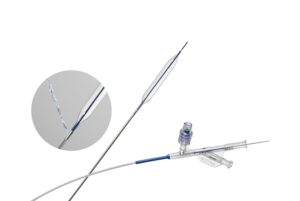
Medtronic recently announced the launch of its Chameleon percutaneous transluminal angioplasty (PTA) balloon catheter in the following countries: Germany, Italy, Portugal, South Africa, Spain, and Turkey. The device is indicated for use in native or synthetic arteriovenous dialysis fistulae, as well as femoral, iliac, and renal arteries. The device enables the infusion of diagnostic or therapeutic fluids via the integrated injection port located proximal to the balloon.
The Chameleon PTA balloon catheter is an over-the-wire catheter compatible with an 0.035” guide wire, enabling the injection of diagnostic fluids, such as contrast medium, or therapeutic fluids to the treatment site through a dedicated opening proximal to the balloon. This design combines the functionality of a traditional diagnostic catheter with a high-pressure PTA balloon providing the user ability to maintain complete guide wire access, simultaneous angioplasty and injection, decreased volume usage, along with reduced procedure and fluoroscopy time.
In January 2021, Medtronic reported the results from the Chameleon AV Access trial published by Joel Crawford (Sutter Medical Group, Roseville, USA) et al in The Journal of Vascular Access. In this clinical study, the investigators found that procedure time, fluoroscopy time, and contrast dose in the Chameleon group was significantly less when compared to the standard PTA group.
Specifically, the use of the Chameleon PTA balloon catheter resulted in the following:
- 34.2% reduction in procedure time (11.7 vs. 7.7 minutes; p=0.0008)
- 27.7% reduction in fluoroscopy time (118.4 vs. 85.6 seconds; p=0.018)
- 49.1% reduction in contrast volume (30.6 vs. 15.9mL; p=0.0001)
Investigators concluded that the use of the Chameleon PTA balloon catheter with an integrated injection port shows potential for a significant reduction in procedure time, fluoroscopy time, and contrast dose when applied in clinical practice.













